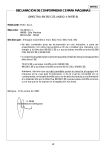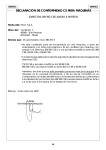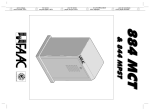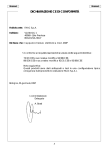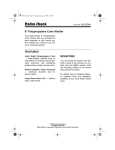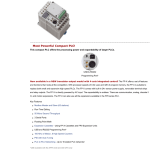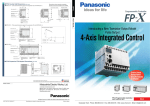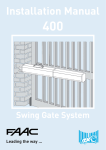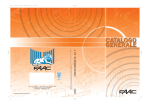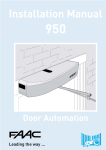Download Installation Manual
Transcript
Installation Manual 820/860 Sliding Gate System Leading the way ... EC MACHINE DIRECTIVE COMPLIANCE DECLARATION (DIRECTIVE 89/392 EEC, APPENDIX II, PART B) Manufacturer: FAAC S.p.A. Address: Via Benini, 1 40069 - Zola Predosa BOLOGNA - ITALY Hereby declares that: the 820-860 automation system • is intended to be incorporated into machinery, or to be assembled with other machinery to constitute machinery in compliance with the requirements of Directive 89/392 EEC, and subsequent amendments 91/368 EEC, 93/44 EEC and 93/68 EEC; • complies with the essential safety requirements in the following EEC Directives: 73/23 EEC and subsequent amendment 93/68 EEC. 89/336 EEC and subsequent amendments 92/31 EEC and 93/68 EEC. and furthermore declares that unit must not be put into service until the machinery into which it is incorporated or of which it is a component has been identified and declared to be in conformity with the provisions of Directive 89/392 EEC and subsequent amendments enacted by the national implementing legislation. Bologna, 1 January 1997 Managing Director A. Bassi 1 IMPORTANT NOTICE FOR THE INSTALLER GENERAL SAFETY REGULATIONS 1) WARNING! FAAC strongly recommends to follow these instructions literally for the safety of persons. Improper installation or misuse of the product will cause very serious damages to persons. 2) Packaging material (plastic, polystyrene etc.) is a potential hazard and must be kept out of reach of children. 3) Read the instructions carefully before installing the product. 4) Keep these instructions for future reference. 5) This product has been designed and manufactured only for the use stated in this manual. Any other use not expressly set forth will affect the reliability of the product and/or could be source of hazard. 6) FAAC S.p.A. cannot be held responsible for any damage caused by improper use or different from the use for which the automation system is destined to. 7) Do not use this device in areas subject to explosion: the presence of flammable gas or fumes is a serious hazard. 8) Mechanical constructive elements must comply with UNI8612, CEN pr EN 12604 and CEN pr EN 12605 standards. Countries outside the EC shall follow the regulations above besides their national normative references in order to offer the utmost safety. 9) FAAC cannot be held responsible for failure to observe technical standards in the construction of gates and doors, or for any deformation of the gates which may occur during use. 10) Installation must comply with UNI8612, CEN pr EN 12453 and CEN pr EN 12635. The degree of safety of the automation must be C+E. 11) Before carrying out any operations, turn off the system’s main switch. 12) An omnipower switch shall be provided for the installation with an opening distance of the contacts of 3 mm or more. Alternatively, use a 6A thermomagnetic breaker with multi-pole switching. 13) Ensure that there is a differential switch up-line of the electrical system, with a trip threshold of 0.03A. 14) Check that the earthing plant is in perfect condition and connect it to the metallic parts. Also earth the yellow/green wire of the operator. 15) The automation is fitted with an anti-crush safety system that is a torque control device. In any case, further safety devices shall be installed. 16) The safety devices (e.g. photocells, safety edges, etc.) protect areas where there is a mechanical movement hazard, e.g. crushing, entrapment and cutting. 17) Each installation must be fitted with at least one flashing light (e.g. FAAC LAMP, MINILAMP etc.) as well as a warning plate suitably fixed to the gate, besides the safety devices as per point 16. above. 18) FAAC cannot be held responsible regarding safety and correct functioning of the automation in the event that parts other than FAAC original parts are used. 19) Use only FAAC original spare parts for maintenance operations. 20) Do not carry out any modifications to automation components. 21) The installer must supply all information regarding manual operation of the system in the event of an emergency and provide the end-user with the "End-user Guide" attached to the product. 22) Keep out of persons when the product is in operation. 23) Keep out of reach of children the remote radio controls and any control devices. The automation could be operated unintentionally. 24) The end-user must avoid any attempt to repair or adjust the automation personally. These operations must be carried out exclusively by qualified personnel. 25) What is not explicitly stated in these instructions is not permitted. 2 AUTOMATION 820 - 860 & 826 MPS These instructions apply to the following models: 820 EMC Z20 CR - 820 EMC - 820 EMC RF - 860 MC Z16 - 860 MC - 860 MC RF - 860 EMC Z16 - 860 EMC The FAAC model 820 and 860 automations for sliding gates are electromechanical operators which transmit movement to the leaf by means of a pinion with rack or chain coupled in an appropriate manner to the sliding gate. The system is guaranteed to be mechanically locked when the motor is not in operation so a lock does not need to be installed. The gear motors have mechanical/ electronic clutches which provide the necessary adjustable anti-crushing safety. A convenient manual release device allows the gate to be operated in the event of a power failure or malfunction. An electronic device allows the open/closed limit switches to be programmed by a simple operation without the need to weld limit switch plates. The electronic control unit is incorporated in the gear motors. The automations 820 - 860 & 826 MPS have been designed and built for vehicle access control. Do not use for any other purpose. 1. DESCRIPTION AND TECHNICAL CHARACTERISTICS where: Ta = opening time Tc = closing time Tp = pause time Ti = interval between one complete cycle and the next. Graph of duty cycle Percentuale di lav. % % Duty cycle % Fréquence d'utilisation % Benutzungsfrequenz % Frecuencia de utilización 100 90 80 70 60 50 40 30 20 4 1 10 2 0 3 12 Table 1 5 7 6 11 8 Fig. 1 10 햲 햳 햴 햵 햶 햷 1 2 3 4 5 6 7 8 9 10 11 12 Tempo (h) Time (h) Temps (h) Zeit (Std.) Tiempo (h) Transformer 826 MPS electronic control unit Surge capacitor Breather/clutch adjustment screw Electric motor ADL electronic card 9 햸 Limit switch unit 햹 햺 햻 햽 햾 Worm screw Crown wheel Emergency release Pinion Casing 1.1. MAXIMUM UTILISATION CURVE The curve allows the maximum working time (T) to be obtained as a function of duty cycle (F). For example, the 820-860 gear motors can operate uninterruptedly at a duty cycle of 30%. To ensure good operation, keep to the field of operation lying below the curve. Important: The curve refers to a temperature of 24°C. Exposure to direct sunlight can result in a reduction in duty cycle to as low as 20%. Calculating duty cycle The duty cycle is the percentage of effective working time (opening + closing) with respect to the total cycle time (opening + closing + pause times). It is calculated using the following formula: Ta + Tc %F = X 100 Ta + Tc + Tp + Ti 3 Gear motor technical characteristics MODEL Power supply Power consumption (W) Reduction ratio No. of pinion teeth Rack Max. thrust daN Winding thermal protection Duty rating Oil quantity (l) Type of oil Temperature range Gear motor weight (kg) Housing protection Max. gate weight (kg) Gate speed Max. gate length Partial opening length Cooling Clutch Housing treatment Casing painting Control unit Limit switches Deceleration Gear motor dimensions LxHxD (mm) Model Motor speed (rpm) Power consumption (W) Current draw (A) Surge condenser Power supply 820 860 230 V (+6% -10%) 400 600 1:30 Z 16 / Z 20 4 module pitch 12.566 50 110 135 °C 30% (see graph) 0,800 FAAC XD 220 -20 to +55°c 14 15 IP 44 600 1200 12 m/min 9,6 m/min 13 m 10 m 1,60 m 1,20 m self-ventilated single disc in oil bath cataphoresis polyester RAL 7042 826 MPS (incorporated) programmable memory (ADL) electronic see Fig. 3 Electric motor technical specifications 820 860 1400 1400 400 600 2 3 20 µF 30 µF 230 V (+6 -10%) 50 Hz 165 40 2. ELECTRICAL SET-UP (standard system) 0¸ 50 Fig. 4 햲 햳 햴 햵 햶 165 40 235 820/860 operator with 826 MPS control unit Photocells Key switch Flashing light Radio receiver 0¸ 50 Fig. 2 235 Fig. 5 accessories and the electricity supply as described in section 2. For ease of connection, ensure that the cables protrude by about 45 cm from the hole in the base plate. 3. DIMENSIONS 140 221,2 Values are expressed in mm. Fig. 3 Fig. 6 4. INSTALLING THE AUTOMATION 53 N.B.: It is advisable to install the base plate on a concrete base raised about 50 mm from the ground (Fig. 7). 2) Assemble the foundation plate as shown in Fig. 6. 3) Prepare a foundation plinth as shown in Fig. 8 and install the base plate providing one or more conduits for electrical cables. Use a level to check that the plate is perfectly horizontal and wait for the cement to set. 4) Set up the electrical cables for connection to the 13 50 • The gate’s structure must be suitable for automation. Take special care to ensure that the wheels are large enough to support the full weight of the gate, that a top runner is installed and that mechanical limit stops are fitted to prevent the gate from coming off the runner. • The characteristics of the ground must ensure sufficient support for the foundation plinth. • There must be no pipes or electrical cables in the area to be dug for installing the foundation plinth. • If the gear motor is located in a vehicle transit area, it is a good idea to provide protection against accidental collisions. • Check that the gear motor has an efficient earth connection. 4.2. INSTALLING THE BASE PLATE 1) The base plate must be positioned as shown in Fig. 4 (right-handed closure) or Fig. 5 (left-handed closure) to ensure that the pinion and rack mesh correctly. Z20 131 mm (820) Z16 123 mm (860) 4.1. PRELIMINARY CHECKS For safe, correct operation of the automation, make sure that the following requirements are met: 221,2 Fig. 7 4.3. MECHANICAL INSTALLATION 1) With the aid of a Teflon hammer insert the adjustable feet into the hexagonal holes under the base of the gear motor as shown in Fig. 9. 2) Remove the casing and position the gear motor on the foundation plate, threading the electrical cables into the conduit in the operator body. 3) Adjust the height of the feet and the distance from the gate as shown in Fig. 7. 4) Secure the gear motor onto the base plate using the two nuts and the plates provided as shown in Fig. 10. 5) Set up the operator for manual operation as described in section 6. 6) Remove the breather screw as shown in Fig. 11 and keep it in a safe place. 4 Fig. 12 3) Rest the first rack element level on the pinion and weld the threaded pawl onto the gate as shown in Fig. 15. 4) Slide the gate manually making sure that the rack rests on the pinion. Weld the second and third pawls. 5) Place another rack element next to the first and use a section of rack to set the teeth of the two elements in phase as shown in Fig. 16. 6) Open the gate manually and weld the three threaded pawls. Proceed in this manner until the entire gate has been covered. Fig. 8 4.4.2. SCREW-ON STEEL RACK (Fig. 13) 2 Fig. 13 1 1) Slide the leaf manually to the closed position. 2) Rest the first rack element level on the pinion and insert the spacer in the upper part of the slot between the rack and the gate. 3) Mark the point to be drilled on the gate. Drill a 6.5 mm diameter hole and thread using 8 mm screw taps. Tighten the bolt. 4) Slide the gate manually making sure that the rack rests on the pinion and repeat the operations of point 3. 5) Place another rack element next to the first and use a section of rack to set the teeth of the two elements in phase as shown in Fig. 16. 6) Slide the gate manually and secure the rack element in the same manner as the first element. Proceed in this manner until the entire gate has been covered. Fig. 9 Fig. 10 Fig. 14 4.4.3. SCREW-ON NYLON RACK (Fig. 14) Fig. 11 4.4. MOUNTING THE RACK 4.4.1. WELD-ON STEEL RACK (Fig. 12) 1) Mount the three threaded pawls on the rack element, positioning them in the upper part of the slot. This way the play provided by the slot will allow for future adjustment. 2) Slide the leaf manually to the closed position. 5 1) Move the leaf manually to the closed position. 2) Rest the first rack element level on the pinion and mark the point to be drilled on the gate. Drill a 4 mm diameter hole and screw on the 6x20 mm self-tapping screw with reinforcement plate. 3) Move the gate manually making sure that the rack rests on the pinion and repeat the operations of point 2. 4) Place another rack element next to the first using a section of rack to set the teeth of the two elements in phase as shown in Fig. 16. 5) Move the gate manually and carry out the fixing operations the same way as for the first element. Proceed in this manner until the entire gate has been covered. Fig. 15 Fig. 19 4.5.2 Fig. 16 7 2 1 1.5 N.B.: Check that none of the rack elements come off the pinion during the movement of the gate. Important: Do not weld the rack elements either to the spacers or to each other (for steel rack only). After installing the rack, lower the position of the gear motor by adjusting the feet (Fig. 17) by about 1.5 mm to ensure correct meshing with the pinion. MODEL 820 EMC RF - 860 MC RF (figs. 20-21) - Insert the elastic pin 7 in the shaft with the aid of a hammer. - Fit the chain pinion on the shaft by matching up the pinion seats with the elastic pin and tighten up screw 4 and washers 5 and 6. - Fit the idle transmission bracket on the gear motor flange, removing the four upper bolts and replacing them with the 5x12 hex bolts 1 and washers 2 in the kit as shown in Fig. 20. - Fit the chain as shown in Fig. 21 and mount the casing with screws 1 and washers 3 (Fig. 20). 6 5 4 3 1 Fig. 20 Fig. 17 Check manually that the gate reaches the mechanical travel limits correctly and that it does not encounter friction during its travel. Do not use grease or other lubricants between the pinion and the rack. 4.5. MOUNTING CHAIN PINIONS In versions for chain and idle transmission applications, mount the Z16 or Z20 chain pinion. Proceed as follows: 4.5.1 MODEL 820 EMC - 860 MC - 860 EMC (figs. 18-19) - Insert the elastic pin in the shaft with the aid of a hammer. - Fit the chain pinion on the shaft by matching up the pinion seats with the elastic pin and tighten up the screw with the washers. Fig. 18 Fig. 21 5. START-UP 5.1. CONNECTION TO ELECTRONIC CONTROL UNIT Warning: Always turn off the electricity supply before carrying out any work on the electronic control unit (connections, programming, maintenance). Warning: When terminal board J2 is disconnected, high voltage remains on the outputs of the capacitor, motor and transformer power supplies. Observe points 10, 11, 12, 13 and 14 in the GENERAL SAFETY INSTRUCTIONS. As shown in Fig. 2, prepare the conduits and make the electrical connections from the 826 MPS electronic control unit to the chosen accessories. 6 5.1.2. Always route the power supply cables separately from the control and safety cables (keyswitch, receiver, photocells, etc.). Use separate conduits to avoid any interference. OPEN A/C STOP FX - 230 V (+6 -10%) 50 Hz 600 W 500 mA 5 W (24Vac) - 20°C + 55°C 1 2 3 4 5 - + 6 7 8 9 11 12 10 FAAC LAMP 4 FX1 1 TABLE3 ACCESSORIES CURRENT DRAW 3 CONTATTO COSTA DI SICUREZZA SAFETY EDGE CONTACT CONTACT TRANCHE DE SÉCURITÉ KONTAKT SICHERHEITSKANTE CONTACTO BANDA DE SEGURIDAD 230 V +6% -10% 50-60 Hz 5 LAMP 24V 3W 13 14 2 TABLE 2 TECHNICAL CHARACTERISTICS OF 826 MPS POWER SUPPLY MAX. MOTOR LOAD MAX. ACCESSORIES LOAD MAX. WARNING LAMP POWER TEMPERATURE RANGE ELECTRICAL CONNECTIONS 4 FX2 3 2 5 1 2 NOMINAL CURRENT DRAW 50mA 20mA 6mA 20mA / 55mA 12mA / 6mA 15mA 15mA 90mA 50mA 70mA 1 2 1 TYPE OF ACCESSORY R 31 PLUS 433 E MINIDEC SL / DS DECODER SL / DS RP 433 ESL / EDS DIGICARD METALDIGIKEY FOTOSWITCH DETECTOR F4 / PS6 MINIBEAM Fig. 23a 5.2. DESCRIPTION OF TERMINAL BLOCK 5.2.1. OPEN (terminals 1-2) 5.1.1. 826 MPS CONTROL UNIT J3 FAAC J8 This means any control device with a N.O. contact which causes the gate to open when activated. In automatic and semiautomatic logics it is active for both opening and closure. J7 826MPS P3 P2 P1 5.2.2. LD5 LD6 LD7 LD8 F2 DECODER 1 2 3 4 5 6 7 8 J1 LD1 LD2 LD3 LD4 5.2.3. DS1 J9 2 3 4 J6 J5 5.2.4. SAFETY FX (terminals 5 - 6) J2 5 6 7 8 9 10 11 12 13 14 MOTOR This means all devices (photocells, safety edges, magnetic loops) with a N.C. contact which stop the movement of the gate when an obstacle is present in the area protected by the safety devices. N.B.: If stop devices are not connected, jumper terminals 5-6. CAP . Fig. 22 Table 4 LD1 LD2 LD3 LD4 LD5 LD6 LD7 LD8 P1 P2 P3 J1 J2 J3 J4 J5 J6 J7 J8 J9 F1 F2 DS1 STOP (terminals 1-4) This means a control device with a N.C. contact which causes the gate status (opening-pause-closure) to be interrupted until the next impulse is sent. N.B.: If stop devices are not connected, jumper terminals 1-4. F1 J4 1 A/C (terminals 1-3) This means any control device with a N.O. contact which causes partial opening of the gate when activated in E1, E2, A1, A2, S1 and S2 logics. In B and C logics it causes the gate to close. 826 MPS control unit components OPEN LED PARTIAL OPEN/CLOSE LED STOP LED SAFETY LED LIMIT SWITCH ALARM LED OPENING LIMIT SWITCH LED CLOSURE LIMIT SWITCH LED SLIDING SPEED LED OPENING LIMIT SWITCH PROGRAMMING BUTTON CLOSURE LIMIT SWITCH PROGRAMMING BUTTON LIMIT SWITCH / RESET PROGRAMMING BUTTON DECODER CONNECTOR LOW VOLTAGE TERMINAL BLOCK ADL CONNECTOR FAAC LAMP OUTPUT TERMINAL BLOCK CAPACITOR CONNECTOR ELECTRIC MOTOR CONNECTOR TRANSFORMER PRIMARY CONNECTOR TRANSFORMER SECONDARY CONNECTOR 230 Vac POWER SUPPLY TERMINAL STRIP ELECTRIC MOTOR FUSE (F 5 A) ACCESSORIES FUSE (T 1.6 A) PROGRAMMING DIPSWITCH 5.2.5. + - LOW VOLTAGE POWER SUPPLY (terminals 6 - 7) These are the 24 Vdc terminals to which the accessories must be connected. Proceed as shown in Table 3 in order not to exceed the maximum permitted load. 5.2.6. LAMP (terminals 8 - 9 - 10) These are the 24 Vac terminals to which the warning lamp must be connected. Warning lamp operation illustrated in Fig. 24 refers to connection to terminals 8-9. Connecting the warning lamp to terminals 8-10 gives inverse operation. 5.2.7. FAAC LAMP (terminals 11 - 12) These are the 230 Vac terminals to which the flashing light must be connected. 5.2.8. 230 V MAINS SUPPLY (terminals 13 - 14) These are the terminals to which the 230 Vac electricity supply must be connected. Connect the earth cable to the post as shown in Fig. 23b. 5.2.9. BEHAVIOUR OF SAFETY DEVICES The safety devices operate during closure only. In A1, E1 and S1 logics, interrupting the safety device contacts causes the gate to stop closing and start opening immediately. In 7 5.4. OPERATION IN VARIOUS LOGICS TABLE 5 LOGIC E1 (SEMIAUTOMATIC) IMPULSES LOGIC E1 GATE STATUS CLOSED OPEN CLOSING OPENING STOPPED STOP no effect no effect stops stops no effect OPEN - A/C (1) opens (2) recloses (2 inverts motion stops recloses (reopens when safety devices are engaged) (2) SAFETY no effect no effect inverts motion no effect no effect TABLE 6 LOGIC E2 (SEMIAUTOMATIC) IMPULSES LOGIC E2 Fig. 23b A2, E2 and S2 logics interrupting the safety device contacts causes the gate to stop closing, then to start opening again when the safety devices are released. 5.2.10. ELECTRONIC SAFETY DEVICE (models 820 EMC - 860 EMC only) The operator is equipped with a system which cuts in when it senses a 20% reduction in pinion speed. The device inverts the closing movement and inhibits opening movement. When this safety device cuts in, LED S goes out for a few seconds. Automatic re-closure is inhibited if the electronic anti-crushing safety has cut in. 5.3. DIPSWITCH SETTINGS N.B.: PRESS THE RESET BUTTON AFTER ALL PROGRAMMING OPERATIONS Logic GATE STATUS CLOSED OPEN CLOSING OPEN -A/C(1)opens (2) recloses (2) inverts motion STOP no effect no effect stops OPENING STOPPED stops recloses (reopens when safety devices are engaged) (2) stops no effect TABLE 7 LOGIC A1 (AUTOMATIC) LOGIC A1 GATE STATUS CLOSED STOP no effect SAFETY no effect OPEN stops counting CLOSING OPENING STOPPED inverts motion no effect recloses (2) stops stops no effect freezes pause until disengagement inverts motion no effect no effect TABLE 8 LOGIC A2 (AUTOMATIC) LOGIC A2 SW1 SW2 SW3 E1 ON ON OFF ON ON S2 ON OFF ON S1 OFF OFF ON B ON ON OFF 5 15 ON ON C OFF ON OFF 10 30 OFF ON E2 ON OFF OFF 30 60 ON OFF A2 OFF OFF OFF 120 180 OFF OFF ON Pause time (sec) (1) Logic A1 A2 S2 S1 SW4 SW5 STOP no effect SAFETY no effect OPEN CLOSING stops counting stops OPENING STOPPED no effect recloses (2) stops no effect recloses after 5 s stops and inverts motion when disengaged (2) no effect no effect TABLE 9 LOGIC S1 (SAFETY) OPEN 2 3 4 5 6 7 IMPULSES OPEN - A/C (1) opens and recloses after pause time (2) recloses after 5 s (3) inverts motion LOGIC S1 GATE STATUS CLOSED 1 IMPULSES OPEN - A/C (1) opens and recloses after pause time (2) recloses after 5 s (3) GATE STATUS CLOSED A1 SAFETY no effect no effect stops and inverts motion when disengaged (2) no effect no effect 8 CLOSING OPENING STOPPED IMPULSES OPEN - A/C (1) opens and recloses after pause time (2) recloses immediately (2 and 3) inverts motion inverts motion recloses (2) STOP no effect SAFETY no effect stops counting recloses after 5 s stops stops no effect inverts motion no effect no effect TABLE 10 LOGIC S2 (SAFETY) Gate closure direction as viewed from inside To right To left SW8 ON OFF LOGIC S2 GATE STATUS CLOSED CLOSING OPENING STOPPED inverts motion recloses (2) OPEN Pre-flashing (2) Yes No SW7 ON OFF Warning light operation (3) ON OFF Closed Opening/Open Off Steady light STOP no effect SAFETY no effect stops counting freezes pause until disengagement stops and inverts motion when disengaged (2) no effect no effect stops stops no effect TABLE 11 LOGIC B (SEMIAUTOMATIC) Gate status SW6 IMPULSES OPEN - A/C (1) opens and recloses after pause time (2) recloses immediately (2 and 3) inverts motion Closing Steady light Flashing (1) Pause times include pre-flashing. (2) Pre-flashing commences 5 seconds before the start of each movement. (3) Warning light connected between 8 and 9 (if connected between 8 and 10, operation is inverted). Fig. 24 LOGIC B GATE STATUS CLOSED OPEN CLOSING OPENING STOPPED 8 IMPULSES OPEN A/C (5) opening (2) no effect no effect no effect completes opening (2) no effect closing (2) no effect no effect completes opening (2) SAFETY (until disengagement) no effect inhibits closing stops no effect inhibits closing STOP no effect no effect stops movement stops movement no effect TABLE 12 LOGIC C (DEADMAN) LOGIC C IMPULSES GATE STATUS OPEN (4) A/C (4 and 5) CLOSED OPEN CLOSING OPENING STOPPED opens no effect no effect no effect closes no effect completes opening completes closing SAFETY (until disengagement) no effect inhibits closing stops no effect inhibits closing STOP no effect no effect stops stops no effect (1) The A/C input enables partial opening. (2) With pre-flashing selected movement starts after 5 seconds. (3) If the impulse is sent after pre-flashing the timer recounts. (4) For operation in C logic keep the pushbutton depressed. Movement stops upon release. (5) The A/C input controls closure. 5.5. PROGRAMMING LIMIT SWITCHES IMPORTANT: CHECK THE LENGTH OF THE GATE. THE OPERATOR HAS A LIMIT SWITCH SYSTEM WHICH ALLOWS FOR AUTOMATION OF GATES WITH A MAXIMUM LENGTH OF 13 m FOR MODELS 820 (Z 20 PINION) AND 10 m FOR MODELS 860 (Z 16 PINION). FAILURE TO OBSERVE THESE RECOMMENDATIONS WILL ADVERSELY AFFECT OPERATION OF THE ADL LIMIT SWITCH. 1) To facilitate installation, it is advisable to program the control unit in E1 logic (semi-automatic) by positioning the relative dipswitches as follows: SW1 - SW2 - SW3 to ON. It is also advisable to inhibit pre-flashing by positioning dipswitch SW7 to OFF. Fig. 26 7) Without moving the gate carry out the following operations on the 826 MPS control unit (Fig. 27) in the stated order: a) hold down FCA. b) press the RESET button for about 1 second. The ADL LED will light up for approximately one second to confirm that the limit switch has been recognised. c) release the FCA button. RESET FCC FCA Fig. 27 SW8 OFF SW8 ON Fig. 25 2) Position dipswitch SW8 according to the direction in which the gate closes (see Fig. 25) (Rack application). IMPORTANT: In chain applications the dipswitch SW8 must be positioned to ON for closure to left and OFF for closure to right. The positions of dipswitches SW4, SW5 and SW6 have no effect. 3) Move the gate manually to its mid-travel position. 4) Switch on the electricity supply to the system and check that the status of the LEDs is as follows: LED ON LED OFF ADL - FCA - FCC S (860) - STOP - FSW OPEN - A/C S (820) 8) Wait for a few seconds, then slide the gate manually until it is a few centimetres from the closed position end stop. 9) Without moving the gate carry out the following operations on the 826 MPS control unit (fig. 27) in the stated order: a) hold down FCC. b) press the RESET button for about 1 second. The ADL LED will light up for approximately one second to confirm that the limit switch has been recognised. c) release the FCC button. 10)Re-engage the operator by sliding the gate until the release device engages. 11)Send an open impulse and check that the gate opens, performs a brief deceleration, then stops at the programmed open position limit switch. 12)Send another impulse and check that the gate closes. 13)To modify limit switch settings, repeat the sequence of operations from point 3) to point 12). IMPORTANT: If the LED starts flashing quickly (0.25 s) during the limit switch setting operations, follow the instructions given in the ALARM CONDITIONS section. IMPORTANT: MAKE SURE THAT THE GATE IS AT ITS MIDTRAVEL POSITION. 5) Remove the safety tab as illustrated in Fig. 26 and keep it for future maintenance work. 6) Open the gate until it is just a few centimetres away from the open position end stop. 9 N.B.: Any interruption in the power supply will not affect memorisation of the limit switch positions. If during a manual operation the gate is moved beyond the memorised limit switch positions, a series of open impulses must be sent to move the gear motor to the zone of normal operation. 5.6. OPERATION OF ADL LIMIT SWITCH The ADL limit switch detects the number of pinion rotations by means of a toothed belt transmission. The operator is supplied with the drive in idle and the ADL system positioned in the mid-travel position. Removing the safety tab engages the transmission. IMPORTANT: If the tab has already been removed by mistake, thereby losing the centre-scale position of the ADL, the following steps must be carried out to restore the start condition: 1) Release the operator. 2) Slide the gate manually to the mid-travel position. 3) Remove the rack element so as to free the pinion. 4) Turn the pinion by hand clockwise or, if the pinion becomes hard to turn, anticlockwise until the ADL (centre scale) LED lights up continuously. 5.7. ALARM CONDITIONS The ADL LED flashes in the following cases: 1) ADL system overrun. 2) Incorrect position of dipswitch SW8. 3) ADL connector removed. 4) Opening/closure time longer than 120 seconds. The warning light (if connected) flashes at the same time as the ADL LED. While this condition is active all the control unit functions are inhibited. It is possible to return to normal conditions only after eliminating the cause of the alarm and pressing the RESET button on the control unit. N.B.: When the warning light flashes with the ADL LED off, this means that fuse F2 has blown. 5.8. REGULATING THE TRANSMITTED TORQUE To regulate the transmitted torque turn the screw on the electric motor shaft (Fig. 11). To increase the torque, turn the screw clockwise. To reduce the torque, turn the screw anticlockwise. IMPORTANT: THE OPERATOR IS DELIVERED WITH THE CLUTCH SET TO MAXIMUM, SO THE SCREW MUST BE TURNED ANTICLOCKWISE TO REACH THE OPTIMAL SETTING. Activate the operator and stop the gate manually to check that the clutch engages. Bear in mind that when this is done with model 820 the electronic anti-crushing device cuts in and stops the movement of the gate if it is opening and reverses it if it is closing. The electronic anti-crushing device activation threshold depends on the setting of the mechanical clutch. 5.9 TESTING THE AUTOMATION When installation is complete, affix the danger warning label to the top of the casing (Fig. 28). Thoroughly check operation of the automation and all connected accessories. Give the customer the User Guide. Explain correct use and operation of the gear motor and draw attention to the potential danger zones of the automation. 6. MANUAL OPERATION If it is necessary to operate the gate manually due to a power failure or malfunction of the automation, operate on the release device as follows. LEVER RELEASE DEVICE (Fig. 29) - Remove the release device rubber cap. - Insert the lever provided into the triangular slot release system and turn clockwise by about half a revolution. - Open or close the gate manually. Fig. 28 NUMBERED KEY RELEASE CAP (Fig. 30). - Open the lock protection flap. - Insert the key into the lock and turn. - Turn the release cap anticlockwise. - Perform the gate opening or closing operation manually. - Turn the release cap anticlockwise. 7. RETURN TO NORMAL OPERATION To prevent an accidental impulse from activating the gate during the operation, turn off the electricity supply to the system before relocking the operator. LEVER RELEASE DEVICE (Fig. 29) - Insert the lever provided into the triangular slot release device and turn anticlockwise by about half a revolution. - Refit the release device rubber cap - Move the gate until the release device engages. NUMBERED KEY RELEASE CAP (Fig. 30). - Open the lock protection flap. - Insert the key into the lock and turn. - Turn the release cap anti-clockwise. - Move the gate until the release device engages. 8. MAINTENANCE When performing maintenance always check that the anti-crushing clutch is correctly regulated and that the safety devices operate correctly. 8.1. TOPPING UP WITH OIL Check the quantity of oil in the operator periodically. For medium-low duty cycles an annual check is sufficient; for more intense use it is advisable to check every 6 months. The level must not fall below the reference notch on the dipstick attached to the oil filler cap (Fig. 31). To top up, unscrew the filler cap (Fig. 31) and pour in oil up to the correct level. Use exclusively FAAC XD 220 oil. 9. REPAIRS For repairs contact an authorised FAAC Repair Centre. 10. ACCESSORIES AVAILABLE 10.1 CORD-OPERATED MANUAL RELEASE If the gear motor is installed in an inconvenient position, it is advisable to use the accessory shown in Fig. 32 to perform the release operation. Pulling on cord A releases the system, whereas pulling on cord B relocks the gear motor. Important: When the automation is reset, move the gate until the release device engages before sending a control impulse. 10 2 1 Fig. 30 Fig. 29 OIL B A Fig. 32 Fig. 31 11 USER’S GUIDE 820 - 860 AUTOMATION Read the instructions carefully before using the product and keep them for future reference. GENERAL SAFETY INSTRUCTIONS If correctly installed and operated, the 820-860 automations ensure a high level of safety. However, some simple rules should be followed to avoid accidents: - Do not stand in the vicinity of the automation or allow anyone else, especially children, to do so and do not place objects in the vicinity of the automation. This is particularly important during operation. - Keep remote controls or any other control device out of the reach of children to prevent them from accidentally operating the automation. - Do not allow children to play with the automation. - Do not deliberately obstruct the movement of the gate. - Make sure that branches or bushes do not interfere with the movement of the gate. - Keep the luminous signalling systems efficient and clearly visible. - Do not attempt to operate the gate manually without first releasing it. - In the event of a malfunction, release the gate to allow access and call a qualified technician for service. - After setting manual operation, disconnect the electricity supply from the system before returning to normal operation. - Do not make any modifications to components belonging to the automation system. - Do not attempt to perform any repair work or tamper with the automation. Call FAAC qualified personnel for repairs. - At least once every six months have the automation, the safety devices and the earth connection checked by a qualified technician. DESCRIPTION The FAAC 820 - 860 automations are ideal for controlling vehicle access areas with medium-high transit frequencies. The 820 and 860 for sliding gates are electromechanical operators which transmit movement to the leaf by means of a pinion with rack or chain coupled in an appropriate manner to the sliding gate. If automatic operation has been selected, sending an impulse causes the gate to reclose on its own after the selected pause time. If semiautomatic operation has been selected, a second impulse must be sent to reclose the gate. An opening impulse send while the gate is reclosing causes it to change direction of movement. A stop command (if available) stops movement at any time. For detailed information on operation of the sliding gate in the various operating modes, contact the installation technician. The automations have safety devices (photocells) which prevent the gate from reclosing when an obstacle lies within the area they are protecting. The system ensures mechanical locking when the motor is not in operation, so it is not necessary to install a lock. For this reason the release system must be used for manual opening. The gear motors have mechanical/electronic clutches which offer the necessary anti-crushing safety. An electronic device allows the open/closed limit switch positions to be programmed. The electronic control unit is incorporated in the gear motors. A convenient manual release device allows the gate to be operated in the event of a power failure or malfunction. The light flashes while the gate is moving. MANUAL OPERATION If the gate has to be operated manually due to a power failure or malfunction of the automation, use the release device as follows. LEVER RELEASE DEVICE (Fig. 1) - Remove the release device rubber cap. - Insert the lever provided into the triangular slot release system and turn clockwise by about 1/2 a revolution. - Open or close the gate manually. NUMBERED KEY RELEASE CAP (Fig. 2) - Open the lock protection flap. - Insert the key in the lock and turn. - Turn the release cap clockwise. - Open or close the gate manually. RETURN TO NORMAL OPERATION To prevent an accidental impulse from activating the gate during the operation, turn off the electricity supply to the system before relocking the operator. LEVER RELEASE DEVICE (Fig. 1) - Insert the lever provided into the triangular slot release device and turn anticlockwise by about half a revolution. - Refit the release device rubber cap. - Move the gate until the release device engages. NUMBERED KEY RELEASE CAP (Fig. 2). - Open the lock protection flap. - Insert the key into the lock and turn. - Turn the release cap anti-clockwise. - Move the gate until the release device engages. Fig. 1 2 1 Fig. 2 23 12 The descriptions and illustrations contained in this manual are not binding. FAAC reserve the right, whilst leaving the main features of the main equipment unaltered, to undertake any modifications it holds necessary for either technical or commercial reasons, at any time and without revising the present publication. FAAC (UK) Limited, 6 Hamilton Close Houndmills Estate, Basingstoke, RG21 6YT Telephone: 01256 318100 Fax: 01256 318101 Email: [email protected] Website: www.faac.co.uk V5 01/07 Your authorised FAAC dealer














